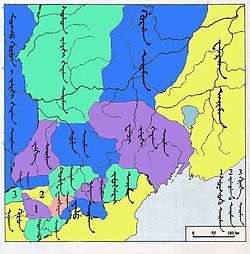Kumo Xi
The Kumo Xi (traditional Chinese: 庫莫奚; simplified Chinese: 库莫奚; pinyin: Kùmò Xī;[1], also known as the Qay or Tatabi, were a Mongolic steppe people located in current northeast China from 207 AD to 907 AD. After the death of their ancestor Tadun in 207 they were no longer called Wuhuan but joined the Khitan Xianbei in submitting to the Yuwen Xianbei. Their history is widely linked to the more famous Khitan.[2] During their history the Kumo Xi engaged in conflict with numerous Chinese dynasties and with the Khitans, eventually suffering a series of disastrous defeats to Chinese armies and coming under the domination of the Khitans. In 1007, the Kumo Xi were completely assimilated into the Khitan Liao Dynasty.
Part of a series on the |
|---|
| History of Manchuria |
 |
|
Ancient period
|
|
Modern period |
Early history

The Kumo Xi and the Khitans were united in a tribal Kumo Xi entity. In 388 AD, the previously defeated Kumo Xi leaders insisted on fighting against with the Xianbei Northern Wei dynasty. When the battlefield seemed to favor Wei, the Khitans fled, leaving the Kumo Xi be crushed.[3] The Kumo Xi were so badly weakened by their defeat to the Northern Wei that the Khitans were able to freely split from the Kumo Xi afterwards, thereby starting their own independent history.
The Kumo Xi were descendants of the Wuhuan. The Hou Hanshu records that “the language and culture of the Xianbei are the same as the Wuhuan”. Along with the Xianbei, the Wuhuan formed part of the proto-Mongolic Donghu confederation in the 4th century BC. The Weishu (Description of the Khitan, Vol. 1000, 2221) records that the Kumo Xi and Khitans (descendants of the Xianbei) spoke the same language.
The Book of Wei (Description of the Khitan, Vol. 100, 2223) records :
契丹國, 在庫莫奚東, 異種同類, 俱竄於松漠之間. 登國中, 國軍大破之, 遂逃迸, 與庫莫奚分背.
The Khitan state was situated east of the Kumo Xi. They were of different origins but belonged to the same ethnic stock, and fled to the region of Songmo together. During the period of Dengguo (386-395), they were severely defeated by the imperial troops. Therefore, they (the Khitan) fled in disorder and split off from the Kumo Xi.
The Book of Sui records:
奚本曰庫莫奚, 東部胡之種.
The Xi were originally called the Kumo Xi. They were of Donghu origin.
The New Book of Tang records:
奚亦東胡種, 為匈奴所破, 保烏丸山. 漢曹操斬其帥蹋頓蓋其後也.
The Xi were also of Donghu (the eastern barbarians) origin. They were defeated by the Xiongnu (under Modu Chanyu), and then sought refuge in the Wuwan Mountains. During the Han Dynasty, Cao Cao killed their leader Tadun. (The Xi) were the descendants.
Conflict with the Tang dynasty
By the early Tang period (around the 7th century AD), the (now named) Xi had become subordinate to the Khitans. After the Khitans' Li-Sun Rebellion (696-697) and revolt of Ketuyu (730-734), the Xi regained their position of dominance. The Xi then entered a golden age, lasting from approximately 755 to 847. During this period the Xi were friendly with An Lushan, and supported An in his An Shi Rebellion (756-763), plundering Han territories frequently within this period. This aggressive policy seems to have consumed Xi forces, especially weakening their demographic vitality, allowing the less aggressive Khitans to dominate them. Xi raids into China provoked successive heavy responses from the Tang, resulting in battles in the 760s and in 795 that were disastrous for the Xi. After 795, the Xi became a tributary people to the Tang.[4]
The Uyghur Empire (744-840) collapsed in the 840's. When the Tang dynasty simultaneously displayed signs of division, the Xi rose in rebellion in 847, and were subsequently and disastrously defeated by Zhang Zhongwu, the frontier commander of Lulong. The Xi were never able to recover from their defeat in 847. In the late ninth century AD the Khitans rose to eventually absorb the remnants of Xi people, and established the Liao Dynasty in 907.[2]
Cultural heritage
It is believed that the Xiqin, a bowed, stringed instrument that is the ancestor of the Chinese Erhu, the Mongolian Khuuchir and Morin khuur, was derived from a Xi instrument.[5][6]
See also
Notes
- Xu Elina-Qian, p.296b
- Xu Elina-Qian, pp.268-271
- Xu Elina-Qian 263-264, 268 for details on this hypothesis: there is no clear source stating that the Khitans fled, but the following decades show that the Khitans were not weakened by the defeat in 388 as much as Kumo Xi were.
- Xu Elina-Qian p.269: defeated by Liu Ji in 795, and Li Zaiyi in 830. p.270: defeated by Zhang Zhongwu in 847
- Suhe Balu
- "Archived copy". Archived from the original on 2013-11-16. Retrieved 2015-04-08.CS1 maint: archived copy as title (link) Хуучир mongol.undesten.mn
References
- Suhe Balu. "The Ancient Legend of the Morin Khuur: The Ancient Legend of Guo'er Luosi". Songyuan Culture. www.0438.cn May 12, 2009. Retrieved on July 4, 2011.
- Xu Elina-Qian, Historical Development of the Pre-Dynastic Khitan, University of Helsinki, 2005. 273 pages. See especially pages: 268-271, 284a.
